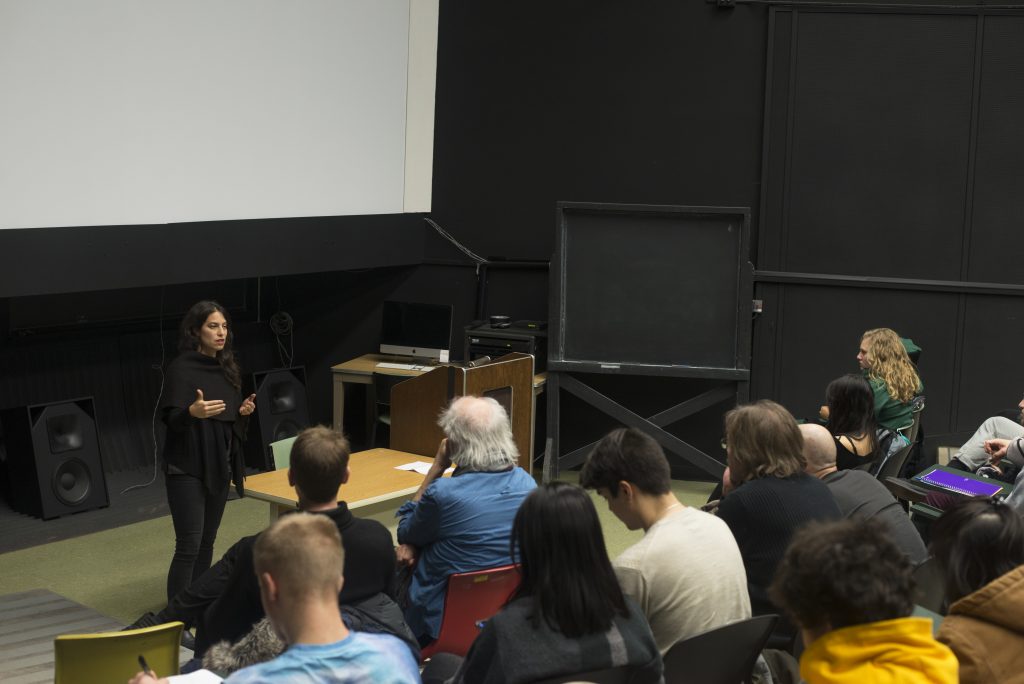
The Visiting Artist’s Series, a national series that highlights a filmmaker’s work and invites them to introduce an audience to their films, visited Binghamton University on Tuesday evening to showcase a series of Malena Szlam’s landscape-inspired experimental films.
Szlam, a Chilean experimental filmmaker who works out of Montreal, visited BU to speak at the screening. Her films are primarily frameless and use moving image works. Tuesday evening’s collection was shot in a variety of films, such as 35 mm, which transitioned to digital, Super 8 mm and 16 mm. The main film of the series, “Altiplano,” was shot in 35 mm.
Szlam was invited for the series by the cinema department for her role in the field and her award-winning works, according to Tomonari Nishikawa, undergraduate director of cinema and an associate professor of cinema.
“[Szlam] is one of the leading artists in this field,” Nishikawa said. “Her work has been shown at many prestigious venues, including International Film Festival Rotterdam, Edinburgh International Film Festival, Toronto International Film Festival, New York Film Festival and Hong Kong International Film Festival, and her latest film, ‘Altiplano,’ has won numerous awards.”
“Altiplano,” the longest film of the series and the only one with sound, studied the Andes Mountains with heavy editing to transform the landscape into a flurry of visual prospects. A frequent underlying theme throughout the series was time and the difficulty of understanding it, as well as nature. The films largely portrayed nature from different perspectives.
Liam Fitch, a junior majoring in cinema, said he enjoyed how nature played a role in the films.
“I thought it was really well structured,” Fitch said. “I really thought that the themes of depicting nature, or of capturing nature in an unconventional way with those infrasounds they were talking about, was very interesting with the tones of the earth and the ocean.”
Fitch said the use of quick editing and overlays stood out to him.
“I liked her use of overlay a lot, of the mountains and the scenery,” he said. “Sometimes she would put a mountain right-side up in the reflection of the light so it looked like there were two horizons. I know she likes editing and using the camera to make really quick edits.”
Each film focused on a specific aspect of nature. “Lunar Almanac” lays out the lunar cycle, with overlapping half-moons to create full moons. The only film to veer from nature as a focus was the first installation of the series, “Chronogram of Inexistent Time.” The film instead uses objects and heavily edited images of people to study stillness and motion.
Nishikawa took note of how the theme of time played a role in the film series.
“The theme of time expressed in her films is complicated,” Nishikawa said. “There is a sense of time that is similar to how we would sense at these sites, and there is one that the viewer will experience in a cinema. There is also a sense of time or duration that she has exposed a frame of the film, especially the part with the moon where the exposure changes from one frame to another.”
According to Szlam, a particularly tenuous part of the series was the sound used in “Altiplano.” Szlam said she produced the sound by editing sounds of nature, such as volcanoes, geysers and Chilean blue whales.
“Producing the soundscape for ‘Altiplano’ was intense labor because we had a deadline of a week for it,” Szlam said. “I spent time in a studio producing the sound, and it was a lot of fun.”
Nishikawa said the screening was a faithful representation of Szlam’s body of work.
“The program was very interesting, showing almost in chronological order so that we would get a sense of how her interests had changed, not changed, and how she had developed her ideas and skills, as well as how she had discovered new methodologies to work with a celluloid medium,” he said.


